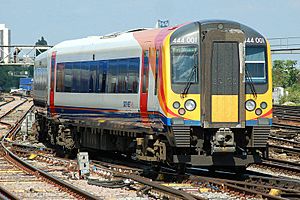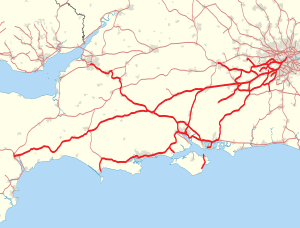South West Trains facts for kids
 |
|||
| Info | |||
|---|---|---|---|
| Franchise(s): | South Western February 1996 – February 2003 February 2003 – February 2007 February 2007 – February 2017 |
||
| Main region(s): | Greater London, Hampshire, Surrey & Dorset | ||
| Other region(s): | Berkshire, Wiltshire, Somerset, Devon | ||
| Fleet size: | 337 (343 including Island Line) 11 Class 158 Express Sprinter sets 30 Class 159 South Western Turbo sets 45 Class 444 Desiro sets 127 Class 450 Desiro sets 91 Class 455 sets 30 Class 458 Juniper sets 1 Class 73 Rescue electro-diesel locomotive (6 Class 483 - Island line sets) |
||
| Stations called at: | 213 (177 operated) | ||
| National Rail abbreviation: | SW | ||
| Parent company: | Stagecoach Group | ||
| Web site: | www.southwesttrains.co.uk | ||
|
|||
South West Trains (SWT) was a train company in England. It was owned by a larger company called Stagecoach. SWT ran trains for over 20 years, from 1996 to 2017.
The company operated many train services. These included trains for people traveling to work in Central London. Its main station was London Waterloo. SWT also ran trains to places in South West London. It was a key operator for longer trips in Surrey, Hampshire, and Dorset.
SWT also offered services in Devon, Somerset, Berkshire, and Wiltshire. It even had a special train service on the Isle of Wight. This service was called the Island Line.
Contents
About South West Trains
South West Trains was a company that operated trains. This means they were in charge of running the trains, managing stations, and selling tickets. They were part of a system where private companies took over train services in Britain. This process is called the privatisation of British Rail.
Where Did South West Trains Go?
SWT covered a large area in the south west of England. This area was once served by the London and South Western Railway.
- London and South West London: Many trains started or ended at London Waterloo. This is one of the busiest train stations in London.
- Outer Suburban Areas: Services reached towns and cities in Surrey, Hampshire, and Dorset. These were popular for daily commuters.
- Regional Services: Longer journeys went to places like Devon, Somerset, Berkshire, and Wiltshire.
- Isle of Wight: The Island Line was a unique part of SWT. It ran trains on the Isle of Wight.
How South West Trains Got Started
In 1996, the British railway system changed. The government decided to let private companies run the trains. This was called "privatisation." Stagecoach Group won the right to operate the South Western train services. This right is called a "franchise."
Stagecoach kept winning the franchise. They won it again in 2004 and 2007. In 2007, the Island Line franchise was added to SWT's services. This made the South Western franchise even bigger.
However, in 2017, a new company won the franchise. This company was called South Western Railway. They took over all the services from South West Trains on August 20, 2017.
The Trains They Used
South West Trains used many different types of trains. Each type was designed for specific journeys.
- Class 444 and 450 Desiro trains: These were modern electric trains. They were often used for longer trips on electrified lines.
- Class 455 trains: These older electric trains were used for shorter journeys. They mainly served the inner suburban areas around London.
- Class 158 and 159 trains: These were diesel trains. They were used for services that went to places without electric lines. This included the long-distance services to Salisbury and Exeter.
- Class 458 Juniper trains: These electric trains were also used on various routes. Some were updated and looked different after their changes.
- Class 483 trains: These were very old trains. They were used only on the special Island Line on the Isle of Wight.
Train Colours and What They Meant
South West Trains used different colours on their trains. These colours helped passengers know what kind of journey the train was making.
- Red Livery: This colour was used for trains on short-distance routes. An example is the Hounslow Loop Line.
- Blue Livery: This colour was for medium-distance services. These trains might go from Southampton Central to Portsmouth & Southsea.
- White Livery: This colour was for long-distance services. These trains traveled far, like from London Waterloo to Exeter St Davids.
Images for kids
-
A Class 444 Desiro unit used on longer-distance services on the electrified railway lines.
-
A Class 159 South Western Turbo unit at Clapham Junction. These were used for long distance West of England Mainline services to Salisbury and Exeter St Davids.
-
A Class 458 Juniper pre-modifications at Clapham Junction
-
A Class 458/5 Juniper post-modifications at Clapham Junction
-
423417 on display at an Open Day at Eastleigh Works in May 2009, alongside one of the operational 3CIG units.
-
The blue symbolised medium distance services, such as the Southampton Central to Portsmouth & Southsea.
-
The white symbolised long-distance services, such as London Waterloo to Exeter St Davids.












